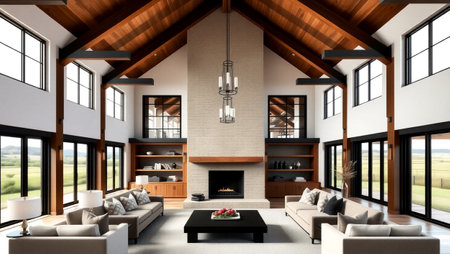Celebrating Heritage: The British Approach to Blending Materials
When it comes to British interior design, there’s an unmistakable sense of history woven into every corner. For generations, traditional British homes have artfully combined wood, metal, and stone in a manner that feels both organic and deeply intentional. This harmonious mix is more than a matter of style—it’s an expression of heritage, shaped by centuries of architectural evolution and local craftsmanship. Wander through a Georgian terrace or a classic country cottage, and you’ll notice how oak beams, wrought iron fixtures, and limestone floors come together effortlessly. These choices reflect the resourcefulness of past eras, when builders relied on local materials and skilled hands to create spaces that would stand the test of time. Today, this approach endures as homeowners seek out ways to blend old with new, always honouring the character and warmth that these natural elements bring to British interiors.
2. The Role of Wood: Warmth and Whimsy in British Interiors
When it comes to British interior design, wood stands as both a backbone and a statement. Its tactile appeal, subtle aroma, and unmistakable warmth are woven into the fabric of daily life, from the honeyed planks of an Edwardian hallway to painted pine kitchen cupboards in a bustling family home. In Britain, timber is more than a construction material; it’s a quiet nod to history and craftsmanship, providing structure while inviting a sense of calm into living spaces.
The Importance of Timber Types
Each type of wood brings its own personality and function to an interior scheme. Whether you’re drawn to the classic charm of English oak or the quirky character of reclaimed elm, choosing the right timber is about finding balance between durability and aesthetics. Here’s a snapshot of how popular woods contribute to British homes:
| Wood Type | Typical Use | Atmosphere Created |
|---|---|---|
| Oak | Floorboards, beams, furniture | Timeless, grounded, robust |
| Pine (often painted) | Cabinetry, shelving, panelling | Cosy, whimsical, adaptable |
| Walnut | Accent furniture, inlays | Luxe, rich, refined |
| Elm (reclaimed) | Tables, benches | Rustic, storied, eco-conscious |
The Allure of Classic Oak Floorboards
No other timber quite matches the sturdy beauty of oak. Its grain tells tales of slow growth and longevity—a fitting foundation for homes that have weathered centuries. Oak floorboards are a staple in both stately period properties and contemporary flats alike; their mellow tones pair effortlessly with metals and stone to create rooms that feel settled yet fresh.
Pine Cabinetry: Painted Personality
Pine is beloved for its versatility. While its natural knots lend rustic charm, many Brits opt to paint pine cabinetry in heritage hues—think sage greens or classic off-whites—bringing playful character without overwhelming a space. It’s this easy adaptability that makes pine a go-to for kitchens and boot rooms alike.
Creating a Grounded Yet Inviting Atmosphere
The British knack for blending wood types lies in balancing tradition with practicality. Mixing oiled oak shelves with painted pine cabinets or setting a walnut sideboard against stone tiles creates layers of visual interest while keeping the overall look welcoming. Ultimately, wood anchors the home—grounding eclectic combinations of metal and stone with its innate warmth and subtle whimsy.

3. Metal as a Modern Accent: Subtle Touches and Bold Statements
While wood and stone provide a grounding sense of heritage in British homes, it’s often metal that brings an unmistakable touch of modernity and character. Across the UK, you’ll find that clever use of metals—whether it’s the gentle gleam of brass handles on a shaker-style kitchen cabinet or the bold lines of wrought iron bannisters winding up a Victorian staircase—helps to balance tradition with contemporary living. Metal elements act as visual punctuation marks, drawing the eye and breaking up natural textures with their distinct sheen and structure.
British interiors are particularly skilled at using metal both subtly and boldly. For instance, slim steel-framed Crittall doors have become an iconic way to divide spaces while maximising light, providing a sleek contrast against softer materials like oak floors or limestone tiles. In period homes, original cast-iron fireplaces are lovingly restored, their intricate designs serving as reminders of craftsmanship from centuries past, yet they sit comfortably alongside more modern metal fixtures. The rise of industrial light fittings—think exposed copper piping or matte black pendants—adds a layer of urban sophistication without overwhelming the space.
It’s not just about aesthetics; practicality is key in British design. Brass taps age gracefully, developing a patina that tells its own story over time, while brushed stainless steel splashbacks offer durability as well as shine. Whether you’re introducing metal through statement pieces or through everyday items like coat hooks and drawer pulls, these accents bring variety in texture and tone, making each room feel thoughtfully curated yet effortlessly lived-in. By weaving metal into the mix, Brits achieve interiors that respect the past while embracing the best of modern style—proof that even the smallest metallic touch can transform the mood of a home.
4. Stonework Stories: From Cosy Hearths to Sleek Countertops
Nothing quite captures the essence of British interiors like the use of locally-sourced stone. From the honeyed tones of Cotswold limestone to the deep slate tiles found in period homes, stonework weaves a narrative of heritage and modern living. Traditionally, stone was at the heart of every home—a sturdy fireplace built from regional materials, providing warmth and acting as a gathering point during chilly evenings. Today, these time-honoured elements blend seamlessly with contemporary design, especially in kitchens where sleek stone countertops meet practicality with style.
The Enduring Charm of Local Stone
British interior designers often look to their surroundings for inspiration, selecting stone that not only reflects the landscape but also reduces environmental impact by cutting down on transportation. Cotswold limestone, renowned for its creamy hue and gentle texture, brings a touch of rustic elegance to both traditional cottages and modern homes. Tiled slate, favoured for its resilience and rich colour palette, offers versatility across floors, splashbacks, and hearths.
Stone in Practice: Where Tradition Meets Modernity
| Stone Type | Traditional Uses | Modern Applications |
|---|---|---|
| Cotswold Limestone | Fireplaces, flooring in country houses | Wall cladding, kitchen islands |
| Tiled Slate | Roofing, flagstone floors | Splashbacks, worktops |
| Yorkstone | Paving, steps | Outdoor patios, statement walls |
Celebrating Craftsmanship and Practicality
The skill of local stonemasons is evident in every curve and join. Whether restoring an inglenook fireplace or fitting a sleek granite counter in a Notting Hill townhouse, there’s an appreciation for durability and understated beauty. Stone surfaces are not just robust—they’re easy to maintain, offering a sense of order and calm that suits both bustling family life and serene solo mornings. In blending old-world textures with minimalist forms, British interiors achieve a delicate balance between comfort and sophistication.
5. Finding Balance: Practical Tips for Mixing Materials in the Home
When it comes to British interior design, finding the sweet spot between character and comfort is key—especially when blending wood, metal, and stone. To achieve a harmonious look without clutter, start by choosing one material as your anchor. For example, oak floorboards or a sturdy stone hearth can set the tone, allowing you to layer in metallic accents like brushed brass handles or iron light fixtures for that subtle touch of contrast. Always pay attention to proportion: if your living room boasts heavy timber beams, balance them with lighter elements such as slim-legged metal tables or small marble accessories. Keep your palette restrained; sticking to two or three core materials per space helps maintain visual order and avoids overwhelming the senses.
Honouring Heritage and Functionality
Embrace what’s already there—a Victorian fireplace or original wooden skirting boards can become natural focal points. Let these features inform your choices elsewhere; perhaps echoing a slate mantelpiece with a few dark metal frames or grounding modern pieces atop a reclaimed elm sideboard. This approach not only pays homage to British architectural heritage but keeps the space feeling practical and lived-in.
Layering Textures Thoughtfully
Think of your home like a well-loved tweed jacket—each material brings its own texture, which adds depth without chaos when chosen carefully. Pair rough-hewn wood with smooth marble for a tactile contrast, then temper with soft textiles in wool or linen for that unmistakable British cosiness. Limit highly reflective finishes to occasional highlights; too much gleam can feel out of place amidst classic stonework or rustic timber.
Declutter with Purpose
Lastly, keep surfaces clear and let each material have room to breathe. Use practical storage—think built-in cupboards with metal pulls or stone-topped console tables—to tuck away everyday items, maintaining a calm sense of order that feels both elegant and unmistakably British. By making mindful choices and celebrating each material’s strengths, you’ll create a home that’s beautifully balanced, functional, and full of local charm.
6. Making it Personal: Collectibles, Textiles, and Storied Layers
While the robust marriage of wood, metal, and stone sets a striking stage in British interior design, it’s the addition of personal touches that truly brings a space to life. British homes are renowned for their ability to blend hard materials with a charming mix of collectibles, textiles, and storied layers—resulting in interiors that feel both curated and comfortably lived-in.
Eclectic Collections
A hallmark of British style is the celebration of collections: from vintage teapots perched on an oak dresser to framed botanical prints above a slate hearth. These curated groupings tell stories of travel, heritage, and personal passions. By nestling cherished objects among sturdy wooden shelves or atop cool marble mantels, British interiors achieve a unique balance—every piece feels purposefully placed yet delightfully unpretentious.
Soft Furnishings for Warmth
No British home is complete without an array of soft furnishings. Plush velvet cushions scattered across a leather Chesterfield sofa or a tartan wool throw draped over a cast iron bedstead add warmth and colour, counterbalancing the rawness of stone floors or metallic lighting fixtures. Textiles are not just for comfort; they’re a visual invitation to relax and linger awhile.
Textured Layers: The Artful Mix
Layering is key to achieving that sought-after “lived-in” look. A sisal rug laid on herringbone parquet, linen curtains framing leaded windows, or embroidered footstools beside wrought iron fire grates—all contribute texture and depth. This layering isn’t accidental; it’s thoughtfully gathered over time, reflecting the evolution of the household and its inhabitants.
The Inviting British Ambience
It’s this harmonious mingling of hard architectural elements with soft, storied details that makes British interiors so inviting. Rather than feeling staged or sterile, these homes exude personality—a sense that every object has its place and every layer adds warmth. The result is a space that welcomes you in, encourages you to explore, and makes you want to stay just a little longer.


